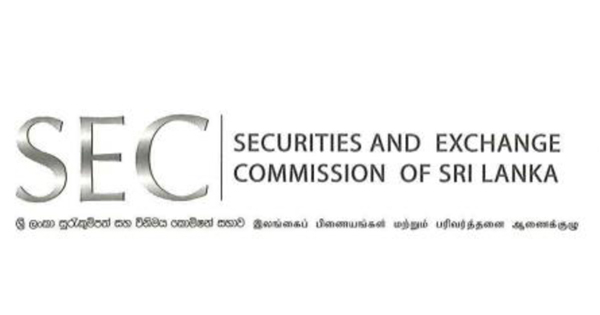January, 25, 2021

The Securities and Exchange Commission (SEC) has approved a set of guidelines for stockbroker firms on good practices at a meeting held on 13 January 2021, the Colombo Stock Exchange (CSE) said in a recent circular.
The approved guidelines have also been presented to the Chief Executive Officers of stockbroker firms on 19 January. The firms will be required to adopt these guidelines with immediate effect.
Under these guidelines, stockbroker firms have to ensure that the brokerage commission applicable to registered investment advisors (RIAs) are at a maximum of 30% in order to maintain consistency within the industry. However, a grace period of three months have been given for the firms to implement this particular guideline.
Furthermore, the guidelines include that; stockbroker firms should appoint a competent person to carry out the functions in relation to information technology (IT) and ensure the necessary IT infrastructure is available within the firm.
Firms must ensure a RIA is allocated to every client and in the event a client is transferred to a different RIA within the company, the company must ensure that Know Your Client (KYC) procedures are verified by the subsequent RIA.
Further, firms must take steps to ensure a succession plan is in place within the firm and that a satisfactory mechanism is in place to train, develop, and retain its employees in line with the current and projected business objectives. Firms should also ensure the key duties and functions of the persons acting in the capacity of compliance and finance are clearly segregated. They should also ensure instructions are recorded and maintained in relation to the orders received from clients in compliance with Rule 3.2 of the CSE stockbroker rules.
The compliance officer will be responsible to ensure the stockbroker firm complies with the proposed best practices. Prior to extending credit to any client, stockbroker firms should take into consideration the value at risk margin of each security and assess the margins with the existing portfolios of each client. The firm should pay particular attention to high, medium, and low margins in deciding the extent of credit to be granted.
The compliance officer should closely monitor the CDS accounts which constantly trade shares with the high VaR margin, accounts which generate high unusual turnover on a consistent basis, carry out the “running account” test on clients who trade excessively, assess the level of compliance with the credit extendable limit and the single client limit more frequently than on a monthly basis, closely monitor the activities of the investment advisor and the credit extended to each client by each investment advisor, and educate the investment advisors of the stockbroker firm with regard to the best practices and develop the ongoing learning culture within stockbroker firm.
The stockbroker firms should send fortnightly notifications to the clients (debtors and creditors over T+3) via electronic means, notifying them of outstanding balances and ensuring that records of such communications are retained. Also, they are to extend the online trading platform to clients who have not opted for the same, with a viewer facility to view the Statement of Accounts, portfolio positions, etc. They are required to obtain acknowledgements from clients randomly, to verify the receipt of statements of accounts, especially clients that carried out high volumes. Following this, stockbroker firms should implement necessary measures to monitor the sector and security exposure on a daily basis. Stockbroker firms should also conduct stress testing, at least weekly, to test the risk levels they may be exposed to, and to ensure they have adequate liquidity to address stressed conditions.
Stockbroker firms also need to ensure established tolerance ratios and limits are in line with business objectives, strategy, and overall risk appetite, in consideration of: Minimum ratio of liquid assets to total assets maximum overnight borrowing to total assets, ratio of assets and liabilities, and any other measures/tolerance limits the management deems necessary.
Moreover, stockbroker firms should ensure reports comparing actual positions against internal limits are routinely prepared and reviewed by its management, and that excesses, irregularities, and potential exposures are promptly reported to its Board of Directors.
The Board of Directors and the senior management of stockbroker firms are responsible for developing and implementing a risk management strategy in accordance with the trade exposure undertaken by the company.
The strategy should include specific policies on credit and liquidity management and, at a minimum, should observe; the composition of assets and liabilities, the diversity and stability of funding sources, the approach to intraday liquidity management, the marketability of assets to be used as contingent sources of liquidity, set objectives for the management of both short- and long-term funding risk, set objectives for the management of contingent liquidity risk, and set the identification of appropriate/inappropriate risk management tools.
Further, the Board of Directors and senior management of stockbroker firms should ensure that a documented risk management and internal control procedure is in place. The firm should ensure the performance of periodic evaluation of the risk management process, internal processors, its internal control procedures and its policies.
Moreover, stockbroker firms should have a documented contingency plan in place, which is approved and reviewed regularly, that will address unexpected events that are likely to impact the entity’s liquidity, including specific procedures for raising cash in emergency situations. The matters to be taken into consideration in formulating the contingency plan should include early warning indicators, contingency scenarios, trigger events, contingency funding strategies, and contingency procedures.
Stockbroker firms should also ensure they have adequately considered their clients’ investment objectives, investment strategy, and financial position when carrying out their functions.
Video Story